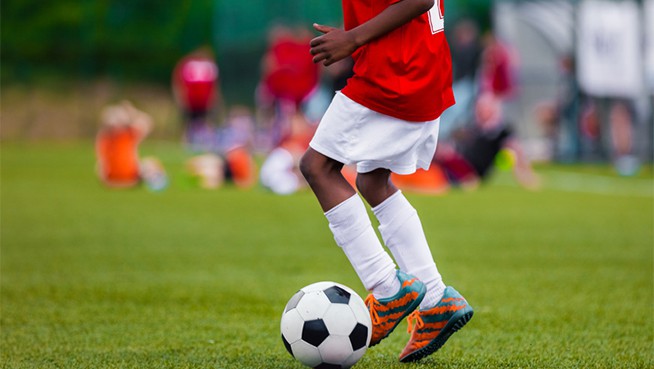3 Linebacker Footwork Drills for Speed and Quickness
To quote the film Remember the Titans, football is about being “lean, mean, agile, hostile and mobile!” These linebacker footwork drills are your solution to meeting these criteria and giving you an edge when your season starts.
The linebacker position is unique on the field in that it requires a combination of grit, technique and athleticism to make plays to get to the ball at all costs. The position demands high levels of concentration, agility and quickness of both mind and body. Split-second decisions and correct footwork can mean the difference between a sack or 6 points for the offense. To be the best in the backfield, it all starts at the feet.
Linebacker is played using four main movements, and you must master them before beginning more complex linebacker footwork drills.
1. Sprinting to close distance to the ball carrier
The sprint seems like a no-brainer, right? However, poor sprint mechanics can result in touchdowns. Begin drilling sprint form using the “Tall Fall Run Drill.” Begin in line with the first cone facing the second cone 15 yards away. On command, begin falling forward by leaning forward while up on your toes. Maintain the fall until you must begin sprinting to avoid falling to the floor. When initially accelerating, keep knee drive high. Imagine breaking a pane of glass at hip level. At a full sprint, remember to keep your elbows near 90 degrees and drive your arms forward so your hands move from the hips near the side pocket position to your cheeks. Your ankles should remain flexed with toes up so that each step lands on the ball of the foot. Sprint full speed through the second cone and decelerate.
2. Backpedaling to drop into pass coverage
In the backpedal, “keep your nose over your toes” to keep your weight forward. Picture pushing the ground away with quick, choppy steps. Begin parallel to the first cone facing away from the second cone 15 yards away. On command, backpedal through the far cone as quickly as possible.
3. Shuffling when reading a play before hitting a gap
For the Shuffle, practice the cue of moving in a low tunnel. Visualize a ceiling just above your head. This will keep you low and prevent lost momentum due to rising and falling. Focus on pushing with your rear leg and pulling with your front leg.
4. Crossover steps when committing to the ball in pass coverage
The final movement, the Crossover, is typically the most challenging, especially for young athletes. One effective cue is to keep your shoulders parallel to the quarterback while your lower body sprints in the direction you want to move. Your hips rotate independently of your torso. Your eyes remain focused on the offensive backfield while your lower body moves to make a play. Begin facing the coach with chopping feet. The coach points left or right, signaling the direction of hip turn. Keep your eyes on the coach at all times while taking crossover steps at a diagonal from one cone to the other.
Once you master these movements individually it’s time to put them all together at game speed. These three linebacker footwork drills work the body through multiple planes of motion and help you to psychologically separate the upper body from the lower body.
Linebacker Footwork Drills
X-Drill
Place 4 cones in a square 8 to 10 yards apart. Move to each cone using a different type of movement and a predefined pattern. For example, you might start at the back left cone, sprint forward to the front left cone, shuffle laterally to the front right cone, crossover diagonally to the starting cone, then sprint to the back right cone. The pattern and sequence of movements can easily be varied to make the drill more challenging. A few sample movement patterns are:
- Sprint, backpedal, shuffle, backpedal
- Shuffle, sprint, crossover, sprint
- Backpedal, shuffle, sprint, crossover
Mini-hurdles can be used to teach knee drive on the sprint and foot height on the shuffle during any phase of the drill.
Agility Arithmetic
Linebackers are often called the quarterbacks of the defense. The position requires rapid decision-making with pinpoint accuracy. This footwork drill requires you to think fast while moving at gameday tempo. Set up 5 cones placed 2 yards apart. Place a 6th cone 8 yards away in line with the central cone.
Begin at the single cone facing the line of five with your feet chopping. Each cone is designated a number, 1 to 5 from left to right. When a coach calls out a number, sprint toward the corresponding cone. After a few steps, before you reach the first cone, coach calls a second number for redirection. Once you touch that cone, sprint back to the starting cone. A simple progression is to use addition and subtraction for the redirection. For example a coach might first yell out 1 then yell out “plus two” to redirect to the third cone. Changes in type of movement can also be used as a progression. For example, you might sprint toward the first cone, then shuffle to second cone on command.
Search and Destroy Drill
This drill simulates lateral movement behind the line of scrimmage before blitzing a gap and pursuing the ball carrier. Set up 4 cones 2 yards apart. The gaps between the cones are assigned letters “A,” “B” and “C.” Coach holds a small beanbag or a football to toss. Begin by laterally shuffling back and forth 4 yards from the line of cones. Coach calls out a gap at random. When you reach the gap, coach tosses the beanbag or ball in any direction, and you sprint to it and break down, chopping your feet.
READ MORE:
RECOMMENDED FOR YOU
3 Linebacker Footwork Drills for Speed and Quickness
To quote the film Remember the Titans, football is about being “lean, mean, agile, hostile and mobile!” These linebacker footwork drills are your solution to meeting these criteria and giving you an edge when your season starts.
The linebacker position is unique on the field in that it requires a combination of grit, technique and athleticism to make plays to get to the ball at all costs. The position demands high levels of concentration, agility and quickness of both mind and body. Split-second decisions and correct footwork can mean the difference between a sack or 6 points for the offense. To be the best in the backfield, it all starts at the feet.
Linebacker is played using four main movements, and you must master them before beginning more complex linebacker footwork drills.
1. Sprinting to close distance to the ball carrier
The sprint seems like a no-brainer, right? However, poor sprint mechanics can result in touchdowns. Begin drilling sprint form using the “Tall Fall Run Drill.” Begin in line with the first cone facing the second cone 15 yards away. On command, begin falling forward by leaning forward while up on your toes. Maintain the fall until you must begin sprinting to avoid falling to the floor. When initially accelerating, keep knee drive high. Imagine breaking a pane of glass at hip level. At a full sprint, remember to keep your elbows near 90 degrees and drive your arms forward so your hands move from the hips near the side pocket position to your cheeks. Your ankles should remain flexed with toes up so that each step lands on the ball of the foot. Sprint full speed through the second cone and decelerate.
2. Backpedaling to drop into pass coverage
In the backpedal, “keep your nose over your toes” to keep your weight forward. Picture pushing the ground away with quick, choppy steps. Begin parallel to the first cone facing away from the second cone 15 yards away. On command, backpedal through the far cone as quickly as possible.
3. Shuffling when reading a play before hitting a gap
For the Shuffle, practice the cue of moving in a low tunnel. Visualize a ceiling just above your head. This will keep you low and prevent lost momentum due to rising and falling. Focus on pushing with your rear leg and pulling with your front leg.
4. Crossover steps when committing to the ball in pass coverage
The final movement, the Crossover, is typically the most challenging, especially for young athletes. One effective cue is to keep your shoulders parallel to the quarterback while your lower body sprints in the direction you want to move. Your hips rotate independently of your torso. Your eyes remain focused on the offensive backfield while your lower body moves to make a play. Begin facing the coach with chopping feet. The coach points left or right, signaling the direction of hip turn. Keep your eyes on the coach at all times while taking crossover steps at a diagonal from one cone to the other.
Once you master these movements individually it’s time to put them all together at game speed. These three linebacker footwork drills work the body through multiple planes of motion and help you to psychologically separate the upper body from the lower body.
Linebacker Footwork Drills
X-Drill
Place 4 cones in a square 8 to 10 yards apart. Move to each cone using a different type of movement and a predefined pattern. For example, you might start at the back left cone, sprint forward to the front left cone, shuffle laterally to the front right cone, crossover diagonally to the starting cone, then sprint to the back right cone. The pattern and sequence of movements can easily be varied to make the drill more challenging. A few sample movement patterns are:
- Sprint, backpedal, shuffle, backpedal
- Shuffle, sprint, crossover, sprint
- Backpedal, shuffle, sprint, crossover
Mini-hurdles can be used to teach knee drive on the sprint and foot height on the shuffle during any phase of the drill.
Agility Arithmetic
Linebackers are often called the quarterbacks of the defense. The position requires rapid decision-making with pinpoint accuracy. This footwork drill requires you to think fast while moving at gameday tempo. Set up 5 cones placed 2 yards apart. Place a 6th cone 8 yards away in line with the central cone.
Begin at the single cone facing the line of five with your feet chopping. Each cone is designated a number, 1 to 5 from left to right. When a coach calls out a number, sprint toward the corresponding cone. After a few steps, before you reach the first cone, coach calls a second number for redirection. Once you touch that cone, sprint back to the starting cone. A simple progression is to use addition and subtraction for the redirection. For example a coach might first yell out 1 then yell out “plus two” to redirect to the third cone. Changes in type of movement can also be used as a progression. For example, you might sprint toward the first cone, then shuffle to second cone on command.
Search and Destroy Drill
This drill simulates lateral movement behind the line of scrimmage before blitzing a gap and pursuing the ball carrier. Set up 4 cones 2 yards apart. The gaps between the cones are assigned letters “A,” “B” and “C.” Coach holds a small beanbag or a football to toss. Begin by laterally shuffling back and forth 4 yards from the line of cones. Coach calls out a gap at random. When you reach the gap, coach tosses the beanbag or ball in any direction, and you sprint to it and break down, chopping your feet.
READ MORE:










